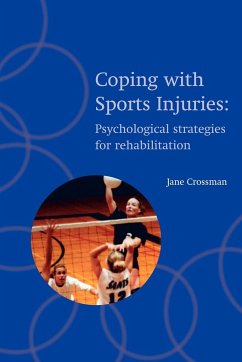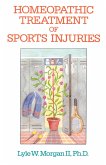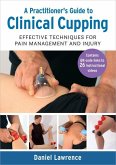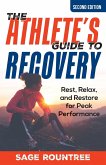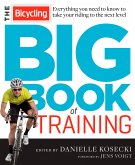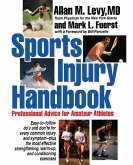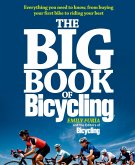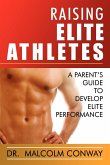Jane Crossman (ed.)Psychological Strategies for Rehabilitation
Coping with Sports Injuries
Psychological Strategies for Rehabilitation
Herausgeber: Crossman, Jane
Jane Crossman (ed.)Psychological Strategies for Rehabilitation
Coping with Sports Injuries
Psychological Strategies for Rehabilitation
Herausgeber: Crossman, Jane
- Broschiertes Buch
- Merkliste
- Auf die Merkliste
- Bewerten Bewerten
- Teilen
- Produkt teilen
- Produkterinnerung
- Produkterinnerung
This text brings together the leading researchers from sports science and medicine to firstly discuss and explain the ways in which the athlete is psychologically affected by injury, before going on to provide effective and proven methods for helping the athlete through this difficult period.
Andere Kunden interessierten sich auch für
![Homeopathic Treatment of Sports Injuries Homeopathic Treatment of Sports Injuries]() Lyle W Morgan IIHomeopathic Treatment of Sports Injuries11,99 €
Lyle W Morgan IIHomeopathic Treatment of Sports Injuries11,99 €![A Practitioner's Guide to Clinical Cupping A Practitioner's Guide to Clinical Cupping]() Daniel LawrenceA Practitioner's Guide to Clinical Cupping15,99 €
Daniel LawrenceA Practitioner's Guide to Clinical Cupping15,99 €![The Athlete's Guide to Recovery The Athlete's Guide to Recovery]() Sage RountreeThe Athlete's Guide to Recovery14,99 €
Sage RountreeThe Athlete's Guide to Recovery14,99 €![The Bicycling Big Book of Training The Bicycling Big Book of Training]() Danielle KoseckiThe Bicycling Big Book of Training17,99 €
Danielle KoseckiThe Bicycling Big Book of Training17,99 €![Sports Injury Handbook Sports Injury Handbook]() Allan M LevySports Injury Handbook17,99 €
Allan M LevySports Injury Handbook17,99 €![The Big Book of Bicycling The Big Book of Bicycling]() Emily FuriaThe Big Book of Bicycling17,99 €
Emily FuriaThe Big Book of Bicycling17,99 €![Raising Elite Athletes Raising Elite Athletes]() Malcolm ConwayRaising Elite Athletes17,99 €
Malcolm ConwayRaising Elite Athletes17,99 €-
-
-
This text brings together the leading researchers from sports science and medicine to firstly discuss and explain the ways in which the athlete is psychologically affected by injury, before going on to provide effective and proven methods for helping the athlete through this difficult period.
Produktdetails
- Produktdetails
- Verlag: OUP Oxford
- Seitenzahl: 224
- Erscheinungstermin: 18. Januar 2001
- Englisch
- Abmessung: 234mm x 156mm x 12mm
- Gewicht: 348g
- ISBN-13: 9780192632159
- ISBN-10: 0192632159
- Artikelnr.: 22212469
- Herstellerkennzeichnung
- Libri GmbH
- Europaallee 1
- 36244 Bad Hersfeld
- gpsr@libri.de
- Verlag: OUP Oxford
- Seitenzahl: 224
- Erscheinungstermin: 18. Januar 2001
- Englisch
- Abmessung: 234mm x 156mm x 12mm
- Gewicht: 348g
- ISBN-13: 9780192632159
- ISBN-10: 0192632159
- Artikelnr.: 22212469
- Herstellerkennzeichnung
- Libri GmbH
- Europaallee 1
- 36244 Bad Hersfeld
- gpsr@libri.de
* 1: Emotional adjustment to sport injury
* Emotional responses to sport injury
* Models of emotional response to sport injury
* Factors associated with emotional responses to sport injury
* Potential consequences of emotional responses to sport injury
* Interventions to facilitate positive emotional adjustment to sport
injury
* Recognition and referral of athletes with poor emotional adjustment
to sport injury
* 2: Assessment of the injured athlete
* A rationale for an integrated psychosocial and physical assessment
* Assessment of the injured athlete
* Primary assessment tool used to measure the impact of injury
* Impression of the injured athlete
* Referral of the injured athlete
* Rationale for the POMS
* Complementary assessment tools
* Identification of barriers
* Tread toward integrated assessment (quality of life)
* 3: The physician's viewpoint
* Classifying injury in sport
* At-risk athletes
* The physician's role in rehabilitation
* Return to play
* 4: The role of the physiotherapist and sport therapist
* Overview of research: what rehabilitation professionals have reported
* Mental skills training: which skills and when?
* Implementation and documentation
* Case studies
* 5: Coping strategies
* Definitions of coping
* Functions of coping
* Types of coping strategies
* Mediators
* 6: Creating an environment for recovery
* Adherence to what: defining the behaviour?
* Determinants of adherence
* Strategies to increase adherence
* 7: Managing thoughts, stress, and pain
* Self-talk
* Other strategies to modify thought content
* Thinking rationally
* Relaxation
* Autogenic training
* Imagery
* Systematic desensitisation
* Non-pharmacological ways of managing pain
* Pain reduction strategies
* Pain focusing techniques
*
* Defining and conceptualising social support: an optimal matching
perspective
* Role of significant others: family members, coaches, and team-mates
* The effects of social support
* Strategies for communicating with significant others
* 9: Returning to action and the prevention of future injury
* Characteristics of the injury
* The prevention of future injury
* Emotional responses to sport injury
* Models of emotional response to sport injury
* Factors associated with emotional responses to sport injury
* Potential consequences of emotional responses to sport injury
* Interventions to facilitate positive emotional adjustment to sport
injury
* Recognition and referral of athletes with poor emotional adjustment
to sport injury
* 2: Assessment of the injured athlete
* A rationale for an integrated psychosocial and physical assessment
* Assessment of the injured athlete
* Primary assessment tool used to measure the impact of injury
* Impression of the injured athlete
* Referral of the injured athlete
* Rationale for the POMS
* Complementary assessment tools
* Identification of barriers
* Tread toward integrated assessment (quality of life)
* 3: The physician's viewpoint
* Classifying injury in sport
* At-risk athletes
* The physician's role in rehabilitation
* Return to play
* 4: The role of the physiotherapist and sport therapist
* Overview of research: what rehabilitation professionals have reported
* Mental skills training: which skills and when?
* Implementation and documentation
* Case studies
* 5: Coping strategies
* Definitions of coping
* Functions of coping
* Types of coping strategies
* Mediators
* 6: Creating an environment for recovery
* Adherence to what: defining the behaviour?
* Determinants of adherence
* Strategies to increase adherence
* 7: Managing thoughts, stress, and pain
* Self-talk
* Other strategies to modify thought content
* Thinking rationally
* Relaxation
* Autogenic training
* Imagery
* Systematic desensitisation
* Non-pharmacological ways of managing pain
* Pain reduction strategies
* Pain focusing techniques
*
* Defining and conceptualising social support: an optimal matching
perspective
* Role of significant others: family members, coaches, and team-mates
* The effects of social support
* Strategies for communicating with significant others
* 9: Returning to action and the prevention of future injury
* Characteristics of the injury
* The prevention of future injury
* 1: Emotional adjustment to sport injury
* Emotional responses to sport injury
* Models of emotional response to sport injury
* Factors associated with emotional responses to sport injury
* Potential consequences of emotional responses to sport injury
* Interventions to facilitate positive emotional adjustment to sport
injury
* Recognition and referral of athletes with poor emotional adjustment
to sport injury
* 2: Assessment of the injured athlete
* A rationale for an integrated psychosocial and physical assessment
* Assessment of the injured athlete
* Primary assessment tool used to measure the impact of injury
* Impression of the injured athlete
* Referral of the injured athlete
* Rationale for the POMS
* Complementary assessment tools
* Identification of barriers
* Tread toward integrated assessment (quality of life)
* 3: The physician's viewpoint
* Classifying injury in sport
* At-risk athletes
* The physician's role in rehabilitation
* Return to play
* 4: The role of the physiotherapist and sport therapist
* Overview of research: what rehabilitation professionals have reported
* Mental skills training: which skills and when?
* Implementation and documentation
* Case studies
* 5: Coping strategies
* Definitions of coping
* Functions of coping
* Types of coping strategies
* Mediators
* 6: Creating an environment for recovery
* Adherence to what: defining the behaviour?
* Determinants of adherence
* Strategies to increase adherence
* 7: Managing thoughts, stress, and pain
* Self-talk
* Other strategies to modify thought content
* Thinking rationally
* Relaxation
* Autogenic training
* Imagery
* Systematic desensitisation
* Non-pharmacological ways of managing pain
* Pain reduction strategies
* Pain focusing techniques
*
* Defining and conceptualising social support: an optimal matching
perspective
* Role of significant others: family members, coaches, and team-mates
* The effects of social support
* Strategies for communicating with significant others
* 9: Returning to action and the prevention of future injury
* Characteristics of the injury
* The prevention of future injury
* Emotional responses to sport injury
* Models of emotional response to sport injury
* Factors associated with emotional responses to sport injury
* Potential consequences of emotional responses to sport injury
* Interventions to facilitate positive emotional adjustment to sport
injury
* Recognition and referral of athletes with poor emotional adjustment
to sport injury
* 2: Assessment of the injured athlete
* A rationale for an integrated psychosocial and physical assessment
* Assessment of the injured athlete
* Primary assessment tool used to measure the impact of injury
* Impression of the injured athlete
* Referral of the injured athlete
* Rationale for the POMS
* Complementary assessment tools
* Identification of barriers
* Tread toward integrated assessment (quality of life)
* 3: The physician's viewpoint
* Classifying injury in sport
* At-risk athletes
* The physician's role in rehabilitation
* Return to play
* 4: The role of the physiotherapist and sport therapist
* Overview of research: what rehabilitation professionals have reported
* Mental skills training: which skills and when?
* Implementation and documentation
* Case studies
* 5: Coping strategies
* Definitions of coping
* Functions of coping
* Types of coping strategies
* Mediators
* 6: Creating an environment for recovery
* Adherence to what: defining the behaviour?
* Determinants of adherence
* Strategies to increase adherence
* 7: Managing thoughts, stress, and pain
* Self-talk
* Other strategies to modify thought content
* Thinking rationally
* Relaxation
* Autogenic training
* Imagery
* Systematic desensitisation
* Non-pharmacological ways of managing pain
* Pain reduction strategies
* Pain focusing techniques
*
* Defining and conceptualising social support: an optimal matching
perspective
* Role of significant others: family members, coaches, and team-mates
* The effects of social support
* Strategies for communicating with significant others
* 9: Returning to action and the prevention of future injury
* Characteristics of the injury
* The prevention of future injury

